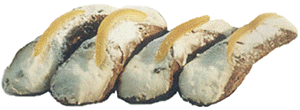...Best of Sicily presents... Best of Sicily Magazine. ... Dedicated to Sicilian art, culture, history, people, places and all things Sicilian. |
by Roberta Gangi | ||
Magazine Index Best of Sicily Arts & Culture Fashion Food & Wine History & Society About Us Travel Faqs Contact Map of Sicily |
The term cannolo comes to us from a diminutive form of canna (a cane-like reed), such as a sugar cane stalk. In medieval times the tubular shell shape was formed by rolling the paste into a flat, circular shape, then wrapping it around a sugar cane stalk. A finger-size miniature version is called the sigaretta (cigarette). Legends abound, but it appears that cannoli were invented in western Sicily, probably in Palermo or its vicinity. They became a springtime item, associated with Fat Tuesday (Carnevale) because the sheep produce more milk for ricotta in the spring when their grazing pastures are green. Spring is still the best time to buy "pecorino" (sheep) ricotta in Sicily. In theory, the crust should be very thin, and the best pastry makers prepare it that way. Thicker tubes are easier to make and fry. Yes, the crusty shells are deep fried to achieve a crispy result, though nowadays some bakers prefer to bake them in an oven. Some commercial bakers coat the inside of the shells with chocolate. That's because they are filling them with cream hours or even days before serving. Ideally, the tubes should be filled immediately (a few minutes) before serving, and the cream should be cold but not close to freezing temperature. Traditionally cannoli are made with fresh ricotta cheese from sheep's milk. Ricotta from cows' milk has a different (milder) flavour. Mascarpone, a poor substitute which is less tasty but higher in fat, is not recommended. Small pieces of candied fruits, particularly lemon, orange, citron and cherry, are sometimes mixed into the cream. Some chefs prefer pistachios or chocolate chips (too often a culinary crutch). In the photo here candied lemon skins are used as an edible decoration. Another idea is to sprinkle the exposed cream with chopped unsalted pistachios. About the Author: Roberta Gangi has written numerous articles and one book dealing with Italian cultural and culinary history, and a number of food and wine articles for Best of Sicily Magazine. | |
Top of Page |
 It is probably the best-known Sicilian pastry. The cannolo, a crust filled with cream, takes its name from its long
tubular shape and traces its roots to the Middle Ages. In the ninth century
the
It is probably the best-known Sicilian pastry. The cannolo, a crust filled with cream, takes its name from its long
tubular shape and traces its roots to the Middle Ages. In the ninth century
the